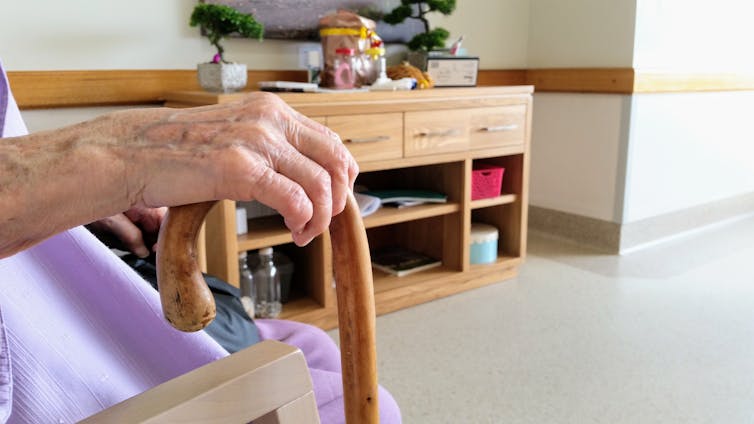Source: The Conversation (Au and NZ) – By Hal Swerissen, Emeritus Professor, La Trobe University

You don’t have to look to far to find examples of poor quality residential aged care. Most recently, residents have too often been un-vaccinated, frightened, isolated, and have died alone in aged care facilities during the pandemic.
It’s tempting to see poor quality as simply the result of extreme circumstances or bad actors behaving incompetently or unscrupulously.
But these problems existed well before COVID. As the Royal Commission into Aged Care Quality and Safety found, they’re built into the system.
Unlike other sectors, such as disability and mental health, Australia doesn’t have a clearly defined, rights-based framework of outcomes for older people when they need care.
Instead, the emphasis has been on managing costs. This has been a particular problem for residential aged care. As a result, Australian residential care has become more privatised and marketised over the past 25 years.
So how has that affected the quality of care? And what can governments do to address this issue?
Snapshot of residential aged care in Australia
The Australian residential aged care system includes around 2,700 services. These are made up of:
- private for-profit organisations, which operate 34% of services
- not-for-profit providers, 57% of services
- government providers, 9% of services.
Around 200,000 Australians live in residential care, at an average cost of around A$90,000 per year. Tax payers contributed around A$13.6 billion in 2019–20.
How do these facilities compare?
Governments want the aged care sector to provide high quality care as efficiently as possible.
In theory, the introduction of private operators promotes market competition. Competition should improve efficiency while maintaining quality.
In practice, there is little evidence this is true – quality costs more.
State government services, which tend to be smaller, charge residents less and provide better quality care than for-profit and not-for-profit providers. This includes nursing hours worked per resident, the rate of assaults per resident, complaints per resident, the use of antipsychotic drugs, and avoidable early deaths.
In research classifying different types of aged care into three tiers of quality (best, middle or worst), just 4% of for-profit providers were in the highest quality tier.
Read more:
There are problems in aged care, but more competition isn’t the solution
Profits increase when costs are kept down. For-profit providers have to deliver returns for their share holders, which leaves less money to reinvest in services compared with not-for-profit and government services.
Pressure to increase efficiency reduces quality through cost-cutting. This includes reduced staffing levels, lower wages and reduced spending on food and other living items for residents. These pressures are there for all aged care providers, but they are greater when profits have to be maintained.
Cutting staffing costs
Staffing costs make up 70% of residential care operating expenses.
Providers reduce staffing costs through the management of staffing ratios and the use of less costly (unskilled) labour. This includes spreading activities such as showering and meals over longer periods, limiting the time scheduled for individual support, and increasing the size of resident groups supported by individual staff members.
The result has been residential care staff are poorly paid and it’s hard to attract and retain them. By international standards, more than half of aged care residents live in facilities with unacceptable levels of staffing. These pressures are greater among for-profit providers.
Read more:
When aged care workers earn just $22 an hour, a one-off payment won’t fix the wage problem
Staff ratios and staff skills and capabilities directly affect the quality of care. Yet one-third of the personal care staff in residential care facilities lack formal qualifications in aged care.
Under-staffing and inadequate training increases the risk of inappropriate and unsafe care and reduces the chance of residents receiving timely care and support. This results in neglect, loneliness and poor health outcomes.
Economies of scale
Private providers optimise profits by building larger institutions where they can more easily manage costs.
Large scale services with more than a hundred beds made up nearly half of the 220,000 residential places available in 2020. And they have increased rapidly, particularly in the private sector. Between 2010 and 2020, private for-profit places increased by one-third and the number of large-scale private places more than doubled.
This trend is mirrored by the increasing market share of the top ten provider groups.

Shutterstock
But size affects quality
Smaller aged care facilities tend to deliver higher quality care.
Large scale institutions, meanwhile, lead to routinised and impersonal environments for both staff and residents. The larger the residential facility, the more likely you are to eat, sleep, shower and move about “on the clock” according to institutional routines.
As a result, residents are often lonely, isolated, unhappy and powerless.
Facilities like these were abandoned a generation ago for people with disabilities and mental illness. Not surprisingly, older Australians overwhelming prefer home and community care, even when they have complex health needs.
What can the government do?
There has been too much emphasis on cost and profit for providers and not enough on quality and outcomes for residents.
The federal government needs to restructure residential aged care to get a better balance between quality and cost. This will require an overhaul of regulation, funding and system management, to put much more emphasis on the quality of resident outcomes and experience.
In particular, residential care should be required to provide:
- small scale, home-like environments
- better integration with community services and facilities for residents
- improved staffing ratios and staff qualifications.
This will cost more.
Read more:
How good design can make aged care facilities feel more like home
The outcomes residents experience in residential services should be monitored much more regularly. And providers must be held accountable for the quality and performance of their services, with funding tied to quality and outcomes – with real consequences for providers who fail to meet these outcomes.
Aged care reform may become a key election issue in the coming months, so we’ll be watching next week’s federal budget closely for new announcements.
![]()
Hal Swerissen is a non Executive Director of the Murray PHN.
– ref. Quality costs more. Very few aged care facilities deliver high quality care while also making a profit – https://theconversation.com/quality-costs-more-very-few-aged-care-facilities-deliver-high-quality-care-while-also-making-a-profit-178022








